After you have done any suspension height adjustment (either increasing or decreasing), you need to take a look at your front axle’s toe-in setting. Likewise, if you have just replaced either your drag link or your tie rod, you need to check your toe-in setting. The TJ runs toe-in…..meaning the leading side of the tires point inward a bit. If you were to measure an imaginary line scribed around the tire on its tread, you would find that the measurement at the front of the tire is slightly less than the measurement taken on the back side of the tire. Properly adjusting your vehicle’s toe-in setting will help improve handling (a TJ with zero toe-in will seem to wander a bit on the road) and it can certainly extend the life of your tires compared to a vehicle where the toe-in is grossly out of spec. It should go without saying that choosing the right tire for your vehicle is just as important as keeping them aligned.
There are a couple of ways to obtain the measurements you will need in order to accurately make your adjustment. The following steps detail the method I use when I am setting my toe-in.
Note: Your tie rod or drag link may not look identical to those shown in this write-up. There are a number of replacement steering setups on the market and some of these were used for the photos in this write-up. None the less, the technique for adjusting your toe-in is the same, regardless of the tie rod or drag link being used.
After parking the vehicle on a flat surface (a driveway should work just fine), use a jack to raise each end of the axle. Place a short jack stand under each end of axle. You need just enough height from the jack stands so that the tires clear the ground and can rotate freely. Do not place the jack stands under the frame. The weight of the vehicle must be on the axle.
Depending on why you are setting your toe-in, you may need to make a “rough” adjustment before you start taking your accurate measurement. If you are replacing your tie rod ends or your tie rod, for example, your tires might very well look as though they are pointing in two different directions. If so, you really need to make a quick adjustment and get them both point straight ahead….or as straight as you can get them by eyeballing it.
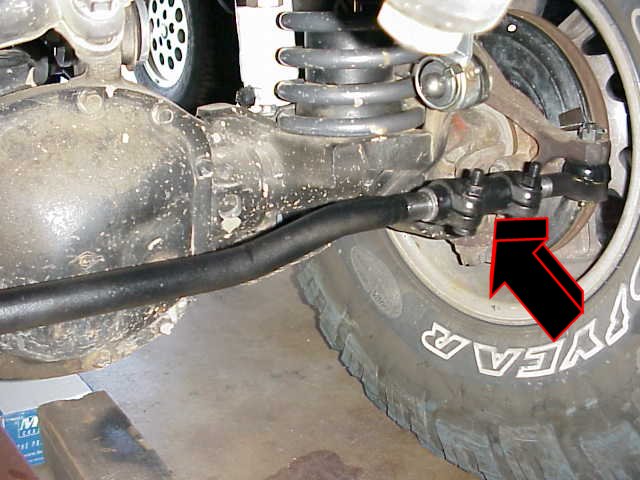
Loosen the two bolts on the adjusting sleeve near driver’s front tire, as shown by the arrow in the above pic. This adjusting sleeve connects the tie rod end to the tie rod. By rotating this adjuster, you can length or shorten the effective length of the tie rod, thus decreasing or increased your toe-in setting.
With the bolts loose, turn the adjusting sleeve so that the tires are more closely pointing in the same direction. If the tires were pointing out and away from each other, turn the adjusting sleeve so that the tie-rod length is reduced (less threads showing). If the tires were pointing too far inward (like being pigeon toed), turn the adjuster so that the tie rod is lengthened (more threads exposed). Sometimes you may need to use some penetrating oil to help loosen up the threads on the adjusting sleeve. A pipe wrench or similar may be needed in order to rotate the adjusting sleeve.
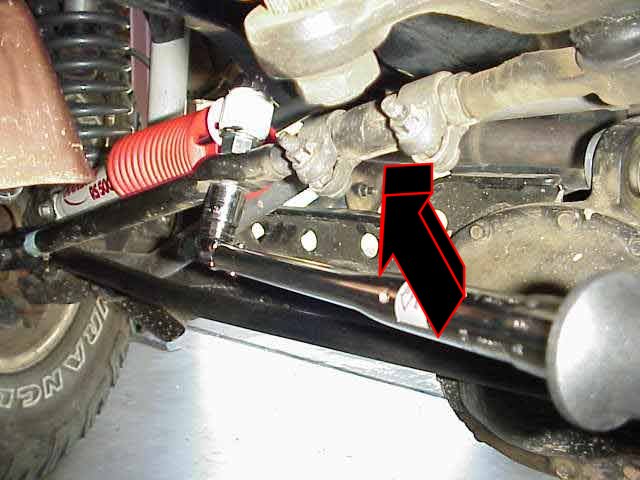
Loosen the two bolts on the adjusting sleeve for the drag link (near the pitman arm), as shown by the arrow in the above picture. (Ignore the torque wrench that is on the steering stabilizer mounting bolt.)
You may need to rotate the adjusting sleeve on the drag link so that the steering wheel is positioned somewhere near its center of travel while you get the tires point straight ahead. Again, it depends on just what you replaced and how far off of the normal the steering components are currently sitting. Don’t worry about the steering wheel being perfectly centered at this point, that will be taken care of later on.
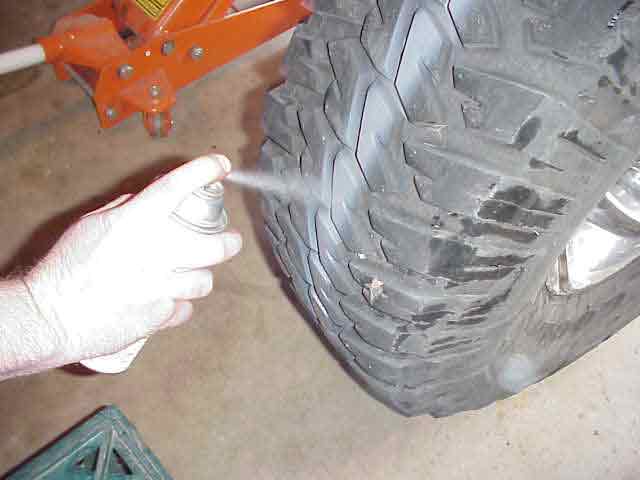
With axle supported by the jack stands just enough to allow the tires to rotate, spin the tire while spraying a bit of your favorite spray paint onto the center of the tire. I usually use some grey primer when I do mine. Apply just enough paint so that you create a clearly visible background for our reference line, which will be created next.

I usually slide a milk crate up to the tire and use a Phillips screw driver (with a good pointy tip) to make the reference line. If a friend is nearby, have them spin the tire while you carefully scribe a line on the freshly painted tire. You can see it in the above picture. Note that you can NOT move the screw drier (or what ever you decide to use) while doing this. The key is that you will have a line on the tire that runs perfectly around the tire in a straight line. It doesn’t have to be in the “middle” of the tire…..it does have to be straight and it can NOT wander back and forth across the tread of the tire. This must be done on both tires. When you finish, you will have a nice thin fine line on each tire that will be used as your reference lines. Don’t worry, if you mess up and get a squiggly line, you can always shoot a little more paint over your mistake and do it again, no problem!
Note: Some folks skip the above step with the spray paint and reference line. In stead, they use the corner of a tread block as their reference point. Personally, I find this very difficult to do with any degree of accuracy. My tread blocks quickly get rounded off from running on the trails. On top of this, the different between a properly set toe-in and one that is not setup correctly is just 1/8″….give or take a 1/32″. Getting that kind of accuracy from a couple of worn down tread blocks is not possible, in my opinion.
OK, you are about two-thirds finished at this time. All that is left is to take a couple of measurements and turn the tie-rod adjusting sleeve a bit until you have things just right. Let’s continue.
Oops….almost forgot, grab a friend and tell them you need them for the next 10 minutes or so.
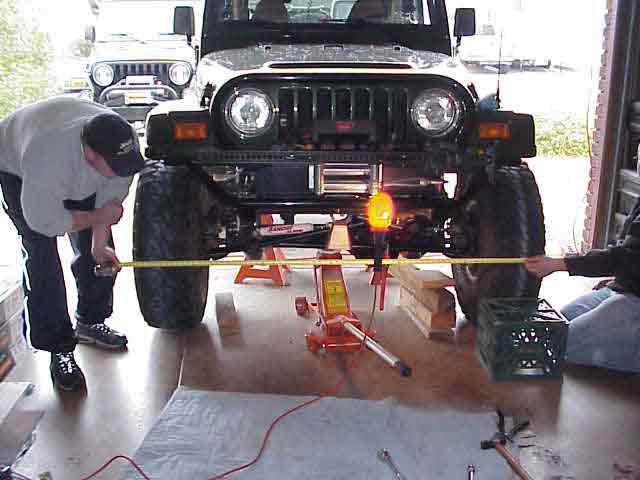
Select a point half way up the height of the tire (on both sides) and measure the distance (between your reference lines) at that spot. Note the exact measurement as accurately as you can (yes, 1/32 of an inch will make a difference here). Now, move the tape measure to the back side of the tires. Again, select a point half way up the height of the tire and take your measurement, just as you did on the front side. For a 35″ tire, the correct toe-in measurement will have your the front and rear measurements differing by slightly more than 1/8″ (with the front measurement being the smaller of the two). About 5/32″ works nicely for a 35″ tire.
It makes no difference what the actual measurements are but only that they differ by approximately 5/32″. Use the adjusting sleeve on the tie rod to either increase or decrease the length of the tie rod. Make your adjustment in small amounts and check both of your measurements (on the front and back side of the tires) each time. You will find that the adjusting sleeve doesn’t need to be moved to far to get a noticeable change in your measurements.
Continue to adjust the tie-rod adjuster until you obtain the desired toe in. Now tighten the two bolts on the adjusting sleeve. You may have to “tweak” the adjuster position a small bit so that the bolts can be clamped down properly and do not interfere with any of the nearby brackets on the axle. Take your time while you do the toe-in and get it right.
TJ Toe-in Alignment
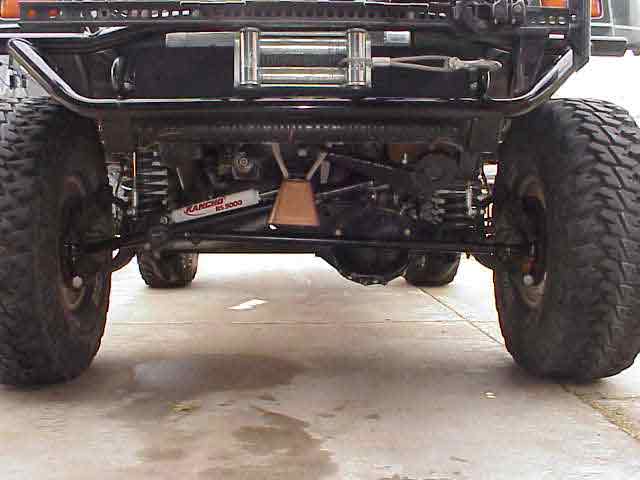
The last thing you need to do is center your steering wheel with your wheels pointing straight ahead. This is done by turning the adjusting sleeve by the pitman arm. (remember, you loosened the two bolts in it on the last page)
Before removing the jack stands, point the tires straight ahead (well, OK….as straight as you can make them). Have your friend watch the steering wheel as you turn the adjusting sleeve on the drag link. As you turn it, the steering wheel will adjust back to the centered position. If the wheel is going in the wrong direction, turn the adjusting sleeve the other way.
When you think you have it centered as good as you can get it, tighten the bolts in the adjusting sleeve and take it for a short test drive. Note the position of the steering wheel while driving straight down the road. If it is off just a bit, back to the driveway you go for another quick adjustment (loosen the two bolts on the drag link adjusting sleeve and rotate it as necessary to center the steering wheel. You might have to do this a couple of times….adjustment, test drive, adjustment, test drive….until the Jeep is going nice and straight and your wheel is properly centered.
That is it! Congratulations, you have just set your vehicle’s toe-in and you saved some money while doing it. If you change your suspension again, take a few minutes and repeat this procedure to verify your toe-in is set properly. It is easy to do and your tires will love you for it!
Good trails and remember…..TREADLightly!
